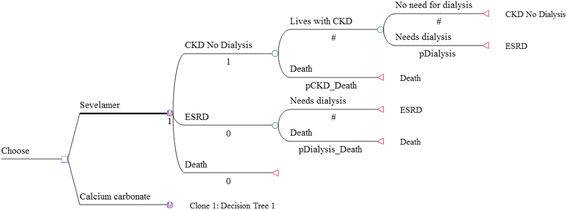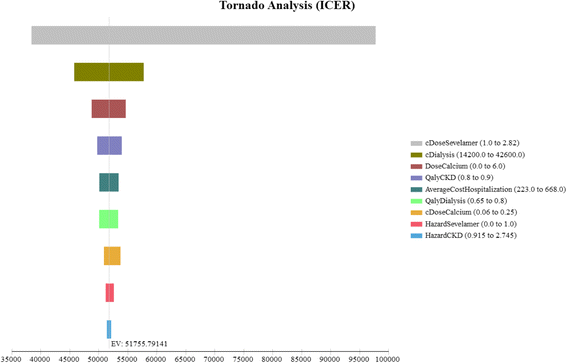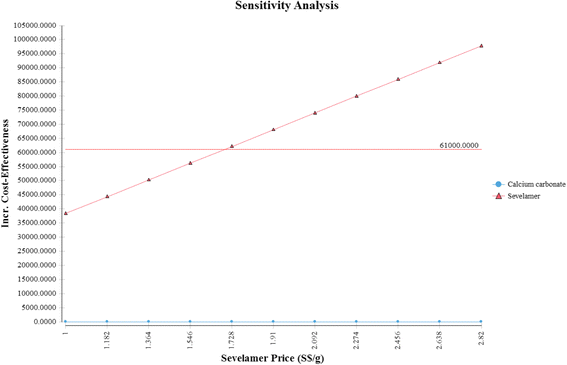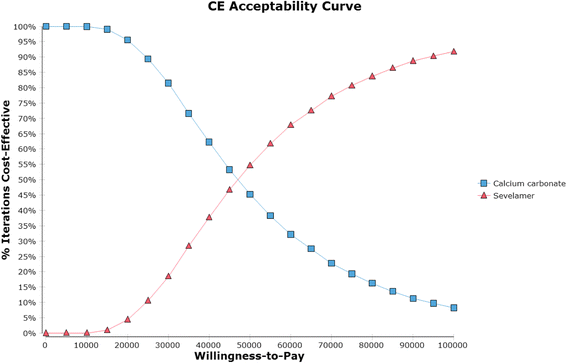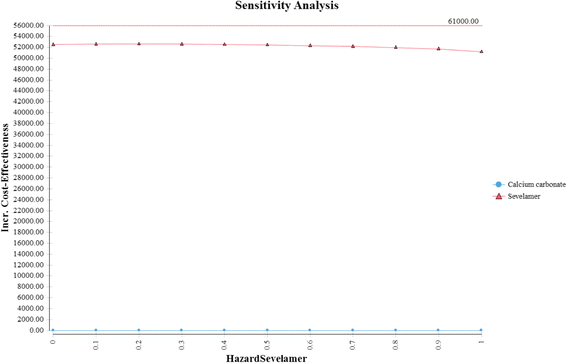Incremental cost-utility of sevelamer relative to calcium carbonate for treatment of hyperphosphatemia among pre-dialysis chronic kidney disease patients
- PMID: 27121505
- PMCID: PMC4848865
- DOI: 10.1186/s12882-016-0256-0
Incremental cost-utility of sevelamer relative to calcium carbonate for treatment of hyperphosphatemia among pre-dialysis chronic kidney disease patients
Abstract
Background: Sevelamer is an alternative to calcium carbonate for the treatment of hyperphosphatemia among non-dialysis dependent patients with chronic kidney disease (CKD). Although some studies show that it may reduce mortality and delay the onset of dialysis when compared to calcium carbonate, it is also significantly more expensive. Prior studies looking at the incremental cost-effectiveness of sevelamer versus calcium carbonate in pre-dialysis patients are based on data from a single clinical trial. The goal of our study is to use a wider range of clinical data to achieve a more contemporary and robust cost-effectiveness analysis.
Methods: We used a Markov model to estimate the lifetime costs and quality-adjusted life years (QALYs) gained for treatment with sevelamer versus calcium carbonate. The model simulated transitions among three health states (CKD not requiring dialysis, end-stage renal disease, and death). Data on transition probabilities and utilities were obtained from the published literature. Costs were calculated from a third party payer perspective and included medication, hospitalization, and dialysis. Sensitivity analyses were also run to encompass a wide range of assumptions about the dose, costs, and effectiveness of sevelamer.
Results: Over a lifetime, the average cost per patient treated with sevelamer is S$180,724. The estimated cost for patients treated with calcium carbonate is S$152,988. A patient treated with sevelamer gains, on average, 6.34 QALYs relative to no treatment, whereas a patient taking calcium carbonate gains 5.81 QALYs. Therefore, sevelamer produces an incremental cost-effectiveness ratio (ICER) of S$51,756 per QALY gained relative to calcium carbonate.
Conclusion: Based on established benchmarks for cost-effectiveness, sevelamer is cost effective relative to calcium carbonate for the treatment of hyperphosphatemia among patients with chronic kidney disease initially not on dialysis.
Keywords: Calcium carbonate; Chronic kidney disease; Cost-effectiveness; Dialysis; Hyperphosphatemia; Sevelamer.
Figures
Similar articles
-
Cost-Effectiveness of First-Line Sevelamer and Lanthanum versus Calcium-Based Binders for Hyperphosphatemia of Chronic Kidney Disease.Value Health. 2018 Mar;21(3):318-325. doi: 10.1016/j.jval.2017.08.3020. Epub 2017 Oct 18. Value Health. 2018. PMID: 29566839
-
Economic evaluation of sevelamer for the treatment of hyperphosphatemia in chronic kidney disease patients not on dialysis in the United Kingdom.J Med Econ. 2013;16(6):744-55. doi: 10.3111/13696998.2013.792267. Epub 2013 Apr 17. J Med Econ. 2013. PMID: 23550810
-
A modeled economic evaluation of sevelamer for treatment of hyperphosphatemia associated with chronic kidney disease among patients on dialysis in the United Kingdom.J Med Econ. 2013;16(1):1-9. doi: 10.3111/13696998.2012.718019. Epub 2012 Sep 10. J Med Econ. 2013. PMID: 22857538
-
A systematic review of the economic evaluations of non-calcium-containing phosphate binders, sevelamer and Lanthanum, in end-stage renal disease patients with hyperphosphatemia.Expert Rev Pharmacoecon Outcomes Res. 2019 Jun;19(3):287-298. doi: 10.1080/14737167.2019.1567336. Epub 2019 Jan 21. Expert Rev Pharmacoecon Outcomes Res. 2019. PMID: 30664365
-
Sevelamer Versus Calcium-Based Binders for Treatment of Hyperphosphatemia in CKD: A Meta-Analysis of Randomized Controlled Trials.Clin J Am Soc Nephrol. 2016 Feb 5;11(2):232-44. doi: 10.2215/CJN.06800615. Epub 2015 Dec 14. Clin J Am Soc Nephrol. 2016. PMID: 26668024 Free PMC article. Review.
Cited by
-
Evaluation of the cost-utility of phosphate binders as a treatment option for hyperphosphatemia in chronic kidney disease patients: a systematic review and meta-analysis of the economic evaluations.Eur J Health Econ. 2021 Jun;22(4):571-584. doi: 10.1007/s10198-021-01275-3. Epub 2021 Mar 6. Eur J Health Econ. 2021. PMID: 33677736 Free PMC article.
-
Cost-effectiveness of phosphate binders among patients with chronic kidney disease not yet on dialysis: a long way to go.BMC Nephrol. 2016 Jul 8;17(1):75. doi: 10.1186/s12882-016-0286-7. BMC Nephrol. 2016. PMID: 27393192 Free PMC article.
-
A Review of Phosphate Binders in Chronic Kidney Disease: Incremental Progress or Just Higher Costs?Drugs. 2017 Jul;77(11):1155-1186. doi: 10.1007/s40265-017-0758-5. Drugs. 2017. PMID: 28584909 Review.
-
Evaluating a multicomponent intervention for managing kidney outcomes among patients with moderate or advanced chronic kidney disease (CKD): protocol for the Strategies for Kidney Outcomes Prevention and Evaluation (SKOPE) randomized controlled trial.Trials. 2024 Oct 30;25(1):730. doi: 10.1186/s13063-024-08564-1. Trials. 2024. PMID: 39472975 Free PMC article.
-
Economic Modelling of Chronic Kidney Disease: A Systematic Literature Review to Inform Conceptual Model Design.Pharmacoeconomics. 2019 Dec;37(12):1451-1468. doi: 10.1007/s40273-019-00835-z. Pharmacoeconomics. 2019. PMID: 31571136 Free PMC article.
References
-
- National Registry of Diseases Office, MOH. Singapore . Singapore Renal Registry Annual Registry Report 1999–2013 (Preliminary) 2014. pp. 1–19.
-
- NKF KDOQI GUIDELINES. 2003. https://www.kidney.org/sites/default/files/docs/boneguidelines.pdf. Accessed 24 April 2016.
Publication types
MeSH terms
Substances
LinkOut - more resources
Full Text Sources
Other Literature Sources
Medical

